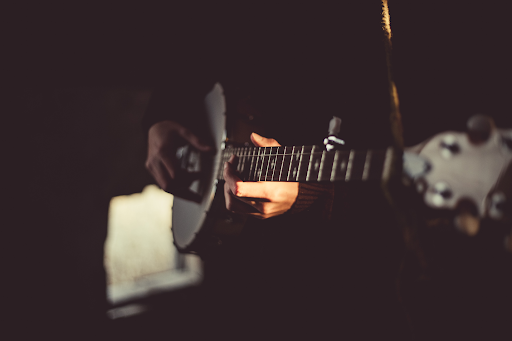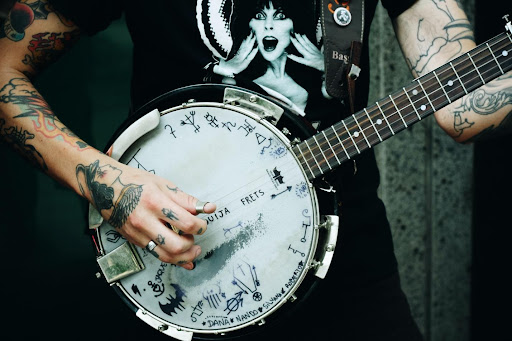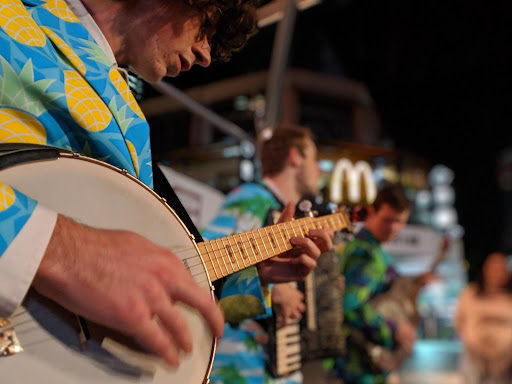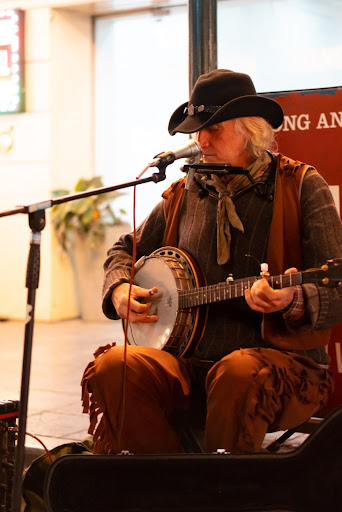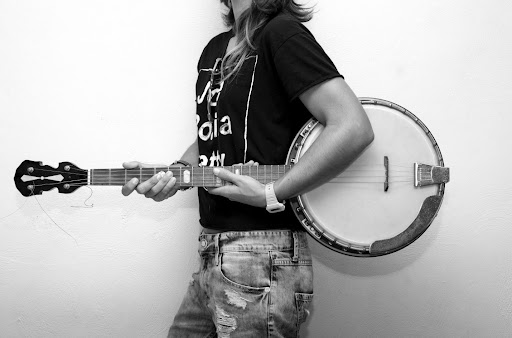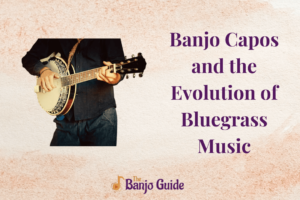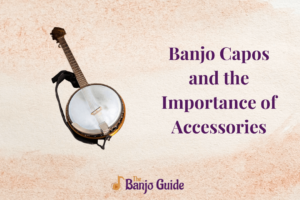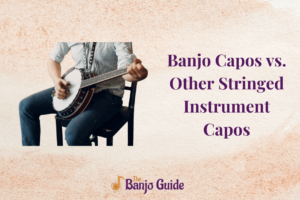Banjo is a popular string instrument with five strings. Banjos look and play much similar to guitars. But banjos have a circular design. But both banjos and guitars have long fret boards that manage tune production.
Capos are specific instruments that are useful to improve banjo playing. It is beneficial for beginners to perform well with a banjo. The following article discusses banjo capos and how banjo capos can enhance your playing.
What are capos?
Capos are devices useful in banjo tuning. They help adjust the pitch of the banjo by clamping down the strings. It looks like a flat finger that presses down the strings.
Keeping the banjo strings closer makes it much easier to play the instrument. It also helps manage the finger positions on the strings much more quickly. Using a capo is a quick and easy way to change keys too.
A capo helps to adjust the keys to bring a song to a comfortable pitch for the singers. Also, it helps change the tension of the strings to create different sounds and textures on a banjo. Having a string capo also eliminates the need for constant retuning.
There are spikes on the down part of the fret capo for stability. You can also use separate spikes on the fretboard called railroad spikes. These railroad spikes go deep into the fretboard and keep the fret capo close to the board.
The spikes also prevent any instances of sliding capos. Spikes are primarily helpful in managing the 5th string and the sixth string. But unlike capos, model railroad spikes can fatigue the banjo string by keeping the string flat for a long time.
Guitar capos are also available. Both guitar capo and banjo capo are present across the fretboard of the stringed instrument. But instruments like mandolin do not use a capo.
Understanding the role of banjo capos in your playing
Capos is an essential piece of equipment for a banjo player. It helps in chord progressions and string tuning.
Especially for beginner banjo players, capos help change the key tune quickly and produce the best sound possible. Banjo capos are much more suitable for playing bluegrass songs. They help achieve the best in open G tuning.
Using capos above the fifth fret is ideal. It produces a fine tune above the fifth fret. It is also advisable not to use a capo on keys D and C. Because it is always better to have a greater number of open strings on a banjo for the best tuning.
If you are playing in keys A, Bb, B, etc., in a traditional style bluegrass, it is best to use a banjo capo. But if you are using the same keys to play a different song, it is fine not to use a banjo capo. While playing in keys C, D, G, or F, playing out of open G works well.
When you want to play the key E, you can both use or not use a banjo capo to achieve the desired fret. You can tune the fifth string to high F or B to produce the sound. Or you can use a capo on the second fret and play as if in key D. Both methods have almost the same sound.
Even though capos work great in G tuning most banjos, it is better not to use them for a long time, especially for devices like the electric guitar. You can use a capo in the beginning stage to control the banjo strings on the banjo neck.
And once you become an experienced banjo player, it is better to decrease the use of banjo capo as much as possible.
Exploring different types of banjo capos and their features
Capo is an essential part of a banjo player’s life. It helps achieve desired musical notes, fine-tuning, excellent pitch, and the right key. Three different types of banjo capos are primarily used in the industry.
Each of them is manufactured based on music theory and has the primary reason of being helpful in producing a great tone. The section below details the three different types of banjo capos.
1. Shubb Fifth String Capo
This capo is screwed onto the side part of the banjo neck. It presses and holds onto the fifth string of the banjo. The traditional banjo capos press onto the first four strings. But here, the pressure is on the fifth string.
You can use a single hand to play with this capo. It is also relatively fast to use this capo. So, you can string tune the instrument even while you are playing.
2. Earls’ Suspender Banjo Capo
This fifth-string capo is more convenient than the other capo models. It is highly compact and can be carried around in a clothing pocket and used as and when necessary. It is comparatively inexpensive too.
This capo consists of a hook covered in a soft rubber material that presses down the fifth string. But as the material is pretty soft, the pull is not very tight; thus, you may have to retune the fifth string occasionally.
3. Spikes
Banjo spikes are model railroad spikes. They are designed like nails with heads. They are drilled into the fretboard so that the heads hold the strings in place.
Most banjo spikes avoid the first four strings. Instead, they are usually drilled from the fifth string side of the instrument. But specific spike models target the first string of the device.
Spikes help control the chords and frets on the banjo neck much better. They are small and do not cause much intrusion on the banjo. The holes the spikes create are tiny; thus, you can shift to any other capo anytime.
But it is essential to install the spikes with an expert. Because otherwise, the installation of spikes can cause damage to the fretboard.
Tips and techniques for using a banjo capo effectively
Some popular tips and techniques for using a banjo capo effectively and enhancing banjo playing are given below.
- Keep the capo as close to the fretboard as possible. Because a loose capo can cause out-of-tune instances.
- Ensure the capo is not too tight, as it could cause the banjo to create a faint sound. It is better to check the string’s tune while tightening the capo.
- You have to tighten a screw capo by turning the head of the screw in a clockwise direction.
- For a sliding capo, you must loosen the screw head and move the capo up and down until you reach the correct fret.
- You can easily open up a clamp capo by pressing on the handles of the capo. Once you squeeze the handles well enough, the capo opens up and can be moved or removed accordingly.
How to choose the right banjo capo for your playing style?
Choosing and picking the suitable capo can help make a positive impact on your banjo playing. Various capos are available in online and offline stores.
For the first four strings
It is better to get a traditional capo for the first four strings. Three standard capos are currently available: elastic, screw, and clamp. Elastic capos are highly inexpensive, but the tuning might be inaccurate.
Screw capos are the most popular ones in this section. They create the right amount of tension on the strings and even help to adjust the pressure conveniently.
Clamp capos have a built0in spring in them that helps with tension adjustment.
For the Fifth String
A sliding capo would be the right choice for the fifth string. It helps the up and down movement across the fretboard much easier.
A sliding capo is usually screwed onto the fretboard. It is ideal to use an expert’s help installing this capo to avoid damaging the fretboard.
For Past Fourth Fret
For keys beyond the fourth fret, especially between the seventh and tenth frets, railroad spikes are the best option.
Railroad spikes also need expert installation. They create smaller holes in the fretboard.
Summary
Capos are essential devices for a banjo that helps in fine-tuning the instrument. It presses down various banjo strings, assisting the player to have more control of the fretboard.
Capos also help with achieving various sounds and textures in banjos and guitars. You are supposed to use different types of capos for different strings. The first four strings of a capo need a traditional capo. The fifth string needs a sliding capo, whereas the remaining strings work well with railroad spikes.
Capos can be an asset for any banjo player with the right tips and techniques. But keeping the capo use for a short term is also advisable. Once you earn expertise in banjo playing, you can limit capos.
FAQs
1. Do I need a capo for the banjo?
A capo is not inevitable for a banjo. You can play the banjo without a capo. But a capo can definitely make the tunes more accurate and proper, especially if you are a beginner. So, using a capo is recommended if you are still to be an expert in banjo playing.
2. Is a banjo capo the same as a guitar capo?
Banjo capo and guitar capo are different in their making. The radius of the capos is quite different. But both serve a common purpose: to fine-tune the instrument.

